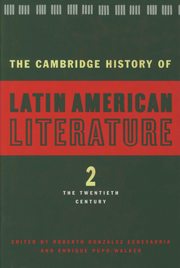Book contents
- Frontmatter
- Introduction to Volume 2
- 1 Modernist poetry
- 2 Modernist prose
- 3 The Vanguardia and its implications
- 4 The literature of Indigenismo
- 5 Afro-Hispanic American literature
- 6 The Criollista novel
- 7 The novel of the Mexican Revolution
- 8 The Spanish American novel from 1950 to 1975
- 9 The Spanish American novel: recent developments, 1975 to 1990
- 10 Spanish American poetry from 1922 to 1975
- 11 The modern essay in Spanish America
- 12 Literary criticism in Spanish America
- 13 The autobiographical narrative
- 14 The twentieth-century short story in Spanish America
- 15 Spanish American theatre in the twentieth century
- 16 Latin American (Hispanic Caribbean) literature written in the United States
- 17 Chicano literature
- Index
- Bibliographies
- References
10 - Spanish American poetry from 1922 to 1975
Published online by Cambridge University Press: 28 March 2008
- Frontmatter
- Introduction to Volume 2
- 1 Modernist poetry
- 2 Modernist prose
- 3 The Vanguardia and its implications
- 4 The literature of Indigenismo
- 5 Afro-Hispanic American literature
- 6 The Criollista novel
- 7 The novel of the Mexican Revolution
- 8 The Spanish American novel from 1950 to 1975
- 9 The Spanish American novel: recent developments, 1975 to 1990
- 10 Spanish American poetry from 1922 to 1975
- 11 The modern essay in Spanish America
- 12 Literary criticism in Spanish America
- 13 The autobiographical narrative
- 14 The twentieth-century short story in Spanish America
- 15 Spanish American theatre in the twentieth century
- 16 Latin American (Hispanic Caribbean) literature written in the United States
- 17 Chicano literature
- Index
- Bibliographies
- References
Summary
Introduction
The space where language becomes poetry is the zone explored by the voices of the twentieth century poetic tradition. Spanish American poetry in the period from 1922 until 1975 allows us to see texts written in the classical mode or in open defiance of it, using a silent, visual language or one that is twisted into beat syncopation. Expression is colloquial, intimate, populist, and baroque. Poets gaze at figurines in museums, or describe the outlines of a room and the shape of a body; they invent bodies and populate imaginary cities, or walk in their cities and transform them into mythical realms. Poems take place in Burma and Rangoon or in the suburbs of Buenos Aires; they illuminate personal chaos and impersonal order, they question the social order or assert the hidden order of things. The debate on the role of the poem, or of the poet, in the modern world, continues, even after the death of poetry is proclaimed in angry manifestos.
General histories of Spanish American poetry have divided this period into three: a period of radical and violent experimentation from 1922 to about 1940, one concerned with the search for American or national cultures that spans the years from 1940 to 1960, followed by a second experimental period that starts from 1960 and lasts until around 1975. The historical markers fall more or less into place if we consider two pivotal events: the Spanish Civil War from 1936 to 1939, and the triumph of the Cuban Revolution in 1959.
- Type
- Chapter
- Information
- The Cambridge History of Latin American Literature , pp. 303 - 364Publisher: Cambridge University PressPrint publication year: 1996
References
- 1
- Cited by



